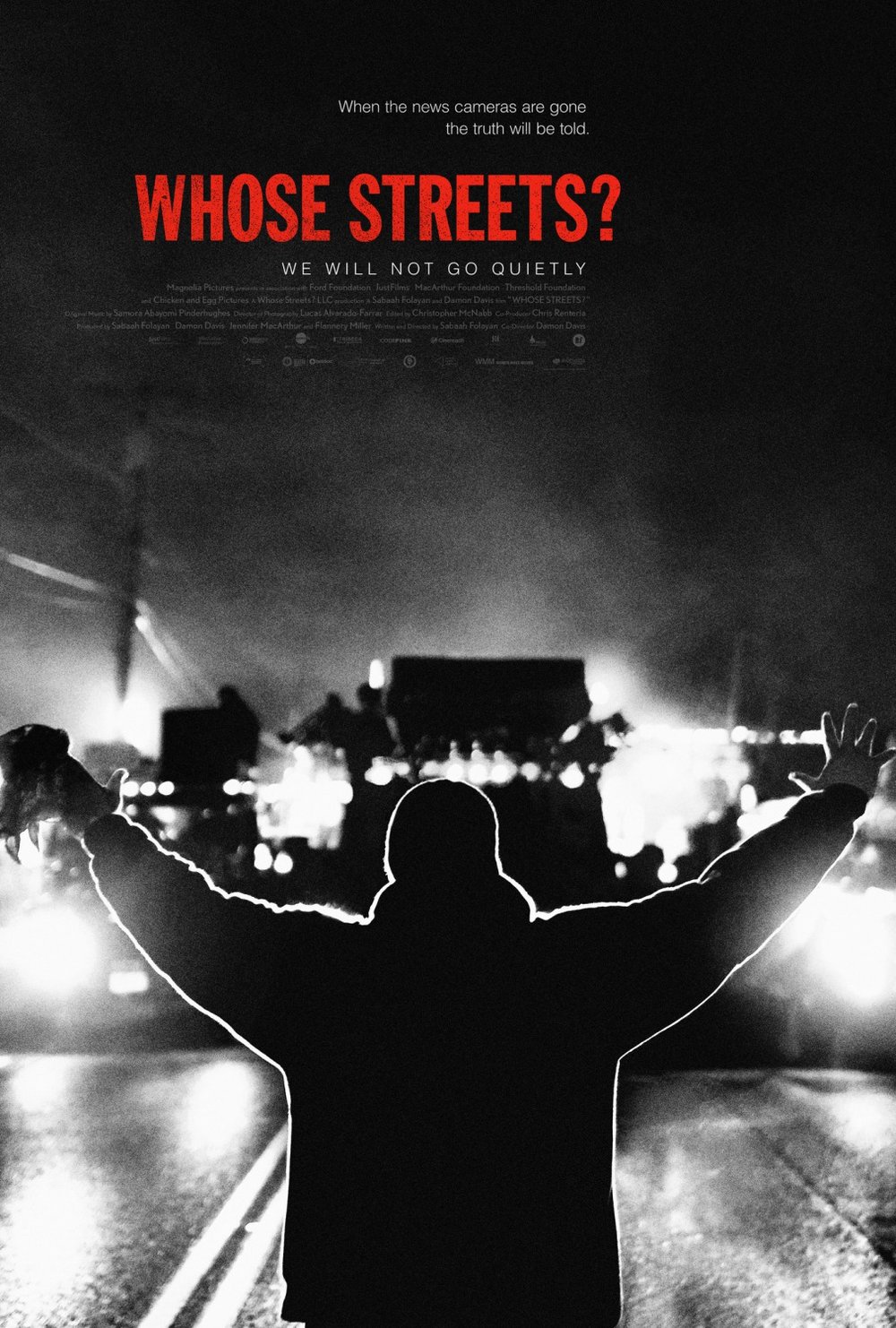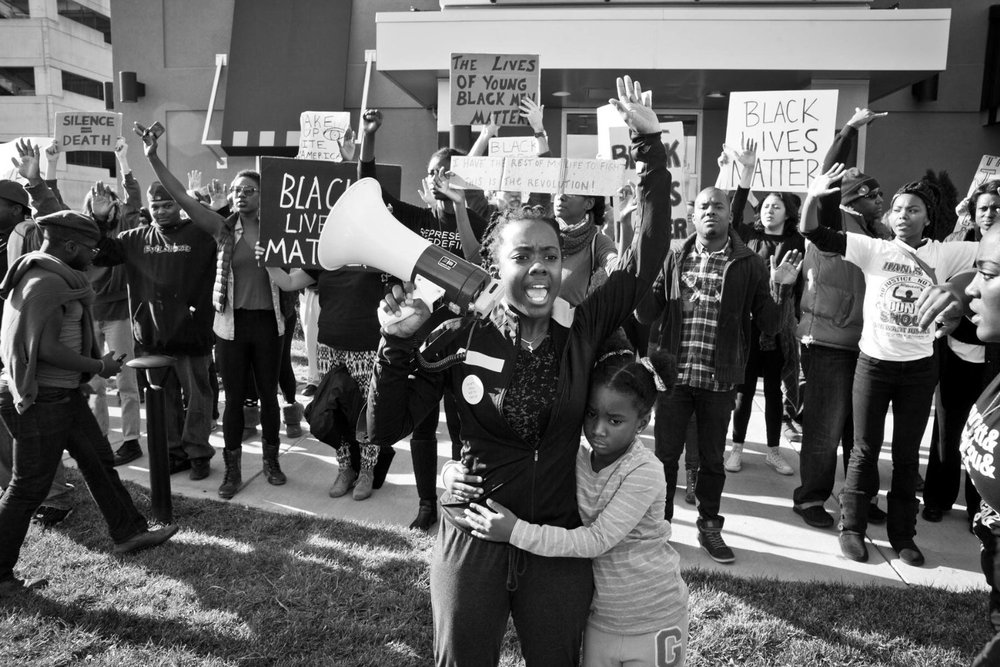Whose Streets? (2017)


SHOULD I SEE IT?
YES
Timely, powerful, and important. Director Sabaah Folayan shares an honest portrayal of how Ferguson, Missouri processed the death of 18-year-old Michael Brown in 2014. Could be in the conversation come Oscar time.
Folayan shows great skill for a first-time filmmaker and crafts a gripping and pulse-pounding film that will leave an impact on engaged audiences.
Showcases elements of the Ferguson story missed by the conventional media. An important visual essay which gives unique perspectives to a controversial moment in recent history.
NO
For those who may personally believe that Michael Brown's actions led to Officer Wilson's taking of his life, I guess none of this will be of much interest or reach you at all.
You are someone who hears the name of "Black Lives Matter" and instantly brands them as a terrorist organization.
"On many sides. On many sides."
OUR REVIEW
"Hands up, don't shoot!"
This phrase, which became a rallying cry for the people of Ferguson, Missouri, and soon across the country for supporters of the Black Lives Matter movement, rose to prominence in the days and months following the death of Michael Brown. Brown was an 18-year-old African-American man, unarmed, fatally shot by a police officer on the morning of August 9, 2014.
Reports circulated that at the time of Brown's death, he had put his hands up and surrendered, only for officer, Darren Wilson, to fire twelve shots towards Brown. An investigation released months later from the Department of Justice claimed that Brown's surrender could not be proven and exonerated Wilson of any wrongdoing. A Grand Jury would soon rule that Wilson acted in self-defense.
Whose Streets? takes us into the heart of Ferguson a few days after Brown's death made national news, and stays over the course of a year. We see the origins of the protests, looting, and an alarming amount of police and government intervention. Officers from several municipalities were called in to Ferguson, as well as the National Guard. Ferguson looked like a war zone.
Director Sabaah Folayan, in collaboration with co-director Damon Davis, incorporates interviews and footage from local and national news, as well as first-hand accounts of the impact Brown's death had on a community with 67% of its residents African-American and 29% white. She unearths a boiling, raging anger and resentment towards systemic inequality between Ferguson's largely white police force, white elected officials, and non-white majority constituency.
Brown's death and Wilson's subsequent acquittal brought widespread attention to the "Black Lives Matter" movement, and Folayan allows key members of the community to offer perspective and opinion. They speak of raising awareness, showing their truth, and starting a conversation about the incidents and situations which Brown's death brought out of the shadows and front and center into the national focus.
Ferguson instantly feels broken when we look at it here. Television cameras, and local and national news reporters descend upon the community, offering a platform for the local voice but also a venue for potential exploitation. Agitation escalates quickly. As the hours and days move away from the Brown incident, police and National Guardsmen order cameras shut off. For almost a week, a police presence rules the streets. People are scared. Some ask questions, some remain sheltered. An unspoken, but very real history appears to haunt everyone.
Watching the film and writing this review comes a few days removed from the Charlottesville protests, where a fleet of white nationalists and American Nazis descended on the legendary Virginia town to allegedly protest the removal of Confederate statues, both in Virginia and across the country. An evolving moment in our history, a woman, Heather Heyer, was killed in the protests when a Nazi sympathizer intentionally drove his vehicle into a crowd of counter-protestors, also injuring 19 other individuals.

Whose Streets? illuminates the fact that a progress many felt had been occurring, regarding a perceived improvement in race relations in America, clearly has not advanced to the level many believed it had. Folayan amplifies a powder keg of emotion that is, at once, raw, real, and powerful to experience.
Residents rightfully complain that news cameras were nowhere to be found when candlelight vigils, peaceful sit-ins, and a restoration of buildings, damaged from looting, brought a community together. When a Brown memorial is burned and destroyed, cameras are absent as community members clean up and rebuild the memorial. A paradox emerges: the media is there, but are they open and affirming to hearing the truth and showing what's actually happening in Ferguson? Or are they looking to craft a separate narrative that is less than accurate and stokes simmering fires?
Folayan shows us a world many whites in America will struggle to comprehend. In the interest of fairness, it should be acknowledged that Whose Streets? does not have law enforcement weighing in on Michael Brown, or the unrest in Ferguson. We do not get infographics or talking head experts. There is no convenience of a deep dive into the history of race relations in Ferguson and America at large.
Along the way we meet David Whitt, the founder of CopWatch, an operation designed to document police behavior in and around the Ferguson community. A young mother, Brittany Ferrell, her wife Alexis Templeton, and their six-year-old daughter, McKenzie, place their lives on hold to invest in the activism that becomes paramount to doing what they believe is the right thing to do. Rapper Tef Poe galvanizes people behind a message of strength, resolve, and peaceful activism.
While I can hear some people bristle at this film's approach in documenting all that has occurred, ignorance feels like the only barrier keeping someone from listening to these stories, hearing these words, taking in these images, and not feeling, on some level, that disadvantage and a lack of justice permeates throughout not just Ferguson, but in a number of minority communities across the country.
But perhaps the film's lingering impact is that Whose Streets? always re-centers itself on themes of hope, on healing and repairing, and on striving to find a way to survive all of this and make things better for the next generation.
Near the end of the film, Brittany offers her thoughts on why she stays active, engaged, and continues to fight against oppression in and around her hometown.
"What keeps me in the movement? This burning desire and vision, and feeling, and love and passion and optimism about liberation. Even though I might not ever live to see what that really looks like, I know what it feels like. And it's that feeling that keeps me going."
CAST & CREW
Documentary Featuring: Brittany Ferrell, Tef Poe, Kayla Reed, Tory Russell, Alexis Templeton, David Whitt.
Director: Sabaah Folayan
Co-Director: Damon Davis
Release Date: August 11, 2017
Magnolia Pictures
